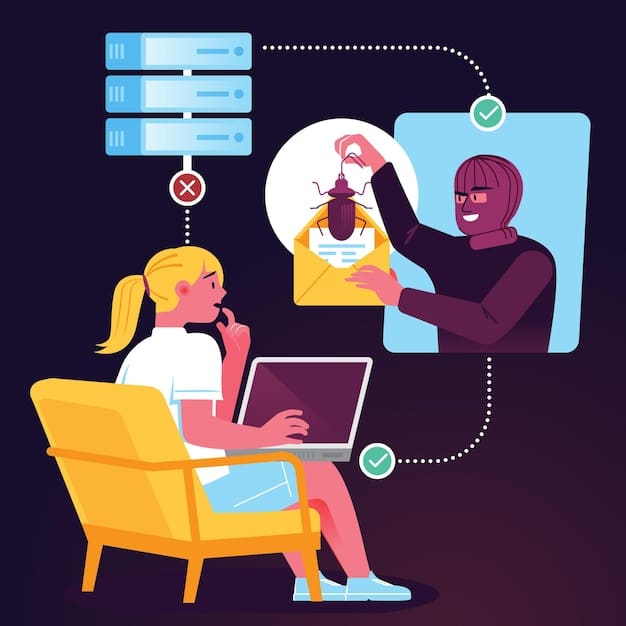Social Media & Mental Health in 2025: A Guide to Navigating the Digital World

Social Media’s Impact on Mental Health: Navigating the Digital Landscape in 2025 explores how evolving social media platforms and digital interactions impact mental well-being, providing strategies for individuals to navigate this landscape effectively and maintain psychological health.
The pervasive nature of social media has fundamentally reshaped how we connect, communicate, and perceive the world. As we move closer to 2025, understanding social media’s impact on mental health: navigating the digital landscape in 2025 becomes increasingly critical to maintaining our well-being in an ever-connected world.
The Evolving Landscape of Social Media and Mental Health
Social media is not static; it continually evolves with new platforms, features, and user behaviors. Understanding these changes is vital to understanding social media’s impact on mental health: navigating the digital landscape in 2025. How do the latest trends affect our psychological state?
Emerging Platforms and Their Psychological Effects
New social media platforms emerge regularly, each with unique features and user demographics. These platforms can have varying psychological impacts from fostering connection to inducing anxiety.
- TikTok: Known for short-form video content, TikTok can lead to decreased attention spans and increased comparison among users.
- Metaverse Platforms: Immersive virtual realities can blur the lines between the physical and digital worlds, potentially causing identity confusion and social isolation.
- AI-Driven Social Media: Algorithms delivering personalized content may create filter bubbles, reinforcing existing beliefs and limiting exposure to diverse perspectives.
As the digital world continues to evolve, understanding the interplay between these platforms and mental health is crucial for fostering healthier online habits.
The Rise of Digital Comparison and its Effects
Digital comparison can lead to feelings of inadequacy and low self-esteem. This issue is prominent as individuals measure themselves against carefully curated online personas.

In conclusion, the evolving landscape of social media’s impact on mental health: navigating the digital landscape in 2025 requires continuous awareness and adaptation. Addressing the psychological effects of emerging platforms and combating the harmful impacts of digital comparison are essential for promoting well-being in the digital age.
The Double-Edged Sword: Connection vs. Isolation
Social media presents a paradox in terms of connection and isolation. While it offers unprecedented opportunities to connect with others, it can also contribute to feelings of loneliness and detachment from real-world interactions. How can we strike a balance?
The Illusion of Connection
Online interactions can sometimes create a false sense of connection by offering a shallow substitute for genuine relationships. Active engagement is key to true connection.
- Superficial Interactions: Liking or commenting on a post does not equate to meaningful engagement.
- Passive Consumption: Scrolling through feeds can lead to feelings of isolation rather than connection.
- Selective Self-Presentation: Users present curated versions of themselves, making authentic connection challenging.
Recognizing these pitfalls can help us navigate social media more mindfully.
Strategies for Cultivating Real-World Relationships
Balancing online and offline interactions is essential for overall well-being. Prioritizing face-to-face connections can have long-lasting mental health benefits.
Fostering healthy relationships off-screen requires intentional effort such as:
- Set Boundaries: Establish time limits for social media use to free up time for in-person interactions.
- Prioritize Quality Time: Engage in activities with friends and family that promote meaningful connection.
- Practice Active Listening: Focus on truly understanding others during conversations rather than planning your response.
By striking a balance between digital and real-world interactions, we can leverage the benefits of social media while mitigating its potential drawbacks.
In closing, the duality of connection versus isolation highlights the importance of intentionality in our social media use, and that it is imperative that we understand social media’s impact on mental health: navigating the digital landscape in 2025. By recognizing the illusion of connection and actively cultivating real-world relationships, we can harness the power of social media to enhance, rather than detract from, our mental well-being.
Cyberbullying and Online Harassment: A Growing Threat
Cyberbullying and online harassment are pervasive issues in the digital age, with potentially devastating effects on mental health. A strong understanding of social media’s impact on mental health: navigating the digital landscape in 2025 must include education on cyberbullying.
The Psychological Impact of Cyberbullying
Cyberbullying can have profound psychological effects on victims, including anxiety, depression, and low self-esteem. The scale of the problem is alarming.
The impacts of cyberbullying extend to the following:
- Emotional Distress: Constant harassment can lead to chronic stress and emotional dysregulation.
- Social Isolation: Victims may withdraw from social interactions to avoid further abuse.
- Increased Risk of Suicide: Severe cases of cyberbullying can contribute to suicidal ideation.
Addressing the issue of cyberbullying requires a multifaceted approach involving individuals, communities, and social media platforms.
Strategies for Combating Online Harassment
Combating online harassment requires a proactive approach from individuals and platforms. Creating a safer online environment is essential.

The following steps can be taken to combat harassment:
- Reporting Mechanisms: Social media companies should implement and enforce clear guidelines for reporting and addressing instances of harassment.
- Bystander Intervention: Encouraging witnesses to intervene or support victims can create a culture of accountability.
- Education and Awareness: Raising awareness about the impact of cyberbullying can foster empathy and prevent future incidents.
By working together, we can create a healthier and more supportive online community.
In summary, addressing cyberbullying and online harassment is crucial for safeguarding mental health in the digital age as we discuss social media’s impact on mental health: navigating the digital landscape in 2025. From understanding the psychological impact to implementing effective strategies for prevention and intervention, we can contribute to a safer and more inclusive online environment.
The Role of Social Media in Shaping Body Image and Self-Esteem
Social media plays a significant role in shaping body image and self-esteem, often leading to feelings of inadequacy and dissatisfaction. As the digital world extends its reach, examining social media’s impact on mental health: navigating the digital landscape in 2025 means evaluating platforms’ influence on self-perception.
Unrealistic Beauty Standards and Their Consequences
Social media platforms often promote unrealistic beauty standards, contributing to body image issues and low self-esteem. Filtered photos and edited images can distort perceptions of reality.
Unrealistic beauty standards can lead to:
- Body Dissatisfaction: Users may develop a negative perception of their own bodies compared to idealized images online.
- Eating Disorders: The pressure to conform to certain body types can contribute to disordered eating behaviors.
- Decreased Self-Worth: Individuals may tie their sense of self-worth to their physical appearance.
Challenging these standards involves media literacy and promoting acceptance.
Promoting Body Positivity and Self-Acceptance Online
Counteracting negative influences involves fostering body positivity and self-acceptance across digital platforms. Promoting diversity is important.
Promoting body positivity and self acceptance involves:
- Diverse Representation: Highlighting diverse body types and appearances can challenge narrow beauty ideals.
- Authenticity: Encouraging users to share unedited and unfiltered content can promote realism.
- Critical Evaluation: Teaching media literacy skills can help individuals critically evaluate the images they encounter online.
By promoting body positivity and authenticity, we can help individuals cultivate a healthier relationship with their bodies and themselves. This is a key factor of social media’s impact on mental health: navigating the digital landscape in 2025.
In short, social media’s influence on body image and self-esteem underscores the need for critical engagement and conscious efforts to promote positivity and self-acceptance. By challenging unrealistic beauty standards and fostering a culture of body positivity, we can mitigate the negative impacts of social media on mental well-being.
FOMO (Fear of Missing Out) and the Pressure to Stay Connected
FOMO, or the Fear of Missing Out, is a pervasive phenomenon fueled by social media where users continuously compare their lives with others. Understanding social media’s impact on mental health: navigating the digital landscape in 2025 includes recognizing the effects of FOMO.
The Anxiety of Constant Connection
The constant connectivity offered by social media can lead to anxiety and a sense of being overwhelmed. Users can feel compelled to stay online at all times.
The constant connectivity can lead to:
- Increased Stress Levels: The pressure to stay updated can elevate stress hormones and contribute to chronic anxiety.
- Sleep Disturbances: Late-night scrolling can disrupt sleep patterns and impact overall well-being.
- Decreased Productivity: The need to check notifications frequently can interfere with focus and productivity.
Learning to disconnect and practice mindfulness can alleviate these effects.
Strategies for Managing FOMO and Disconnecting
Managing FOMO involves intentional strategies for disconnecting and prioritizing real-life experiences. Establishing boundaries is crucial.
- Digital Detox: Taking breaks from social media can help reduce anxiety and foster a sense of calm.
- Mindfulness Practices: Focusing on the present moment can help individuals appreciate their current experiences.
- Setting Boundaries: Establishing specific times for social media use can prevent constant connectivity.
By implementing these strategies, individuals can regain control over their digital habits and enhance their mental well-being.
In conclusion, addressing FOMO and the pressure to stay constantly connected requires conscious effort and intentional strategies for disconnecting. By understanding the anxiety of continuous connection and implementing practical techniques for managing FOMO, individuals can cultivate a healthier relationship with social media and enhance their overall well-being. This is a key indicator in social media’s impact on mental health: navigating the digital landscape in 2025.
Building a Healthier Digital Lifestyle in 2025
Building a healthier digital lifestyle requires conscious effort and the adoption of mindful online habits. Understanding social media’s impact on mental health: navigating the digital landscape in 2025 is a key first step to improved online behavior.
Mindful Social Media Consumption
Be more conscious of the content you consume. Understanding the content to which you are exposed on social media is the first step to filtering harmful influences.
- Curate Your Feed: Unfollow accounts that trigger negative emotions or promote unrealistic standards.
- Engage Meaningfully: Interact with content that inspires and uplifts you.
- Limit Passive Scrolling: Set specific times for social media use and avoid aimless browsing.
Focus on positive content and engagement.
Promoting Digital Wellness and Balance
Creating a digital wellness plan that incorporates breaks, real-world interaction, and self-care activities is vital to a healthy, long life. Healthy habits are essential.
Adopting digital wellnes practices involves:
- Prioritize Offline Activities: Engage in hobbies and interests that don’t involve screens.
- Practice Self-Care: Dedicate time to activities that promote relaxation and well-being.
- Seek Support: Connect with friends, family, or professionals when feeling overwhelmed.
These steps can set you on the path to a healthy digital lifestyle.
In summary, building a healthier digital lifestyle in 2025 hinges on mindful consumption, balanced digital habits, and intentional strategies for promoting well-being. By adopting these practices, we can leverage the benefits of social media while mitigating its potential drawbacks, fostering a healthier and more fulfilling digital existence.
| Key Point | Brief Description |
|---|---|
| 📱 Digital Comparison | Unrealistic standards lead to inadequacy; counteract with authenticity. |
| 🗣️ Cyberbullying | Causes distress; strategies: report, intervene, educate. |
| 😟 FOMO | Creates anxiety; manage with detox, mindfulness, boundaries. |
| 💪 Digital Wellness | Curate feed, prioritize offline, seek support for a healthier lifestyle. |
FAQ
▼
It often leads to comparison with others, impacting self-worth. Unrealistic beauty standards and curated content can cause feelings of inadequacy, which can result in decreased self-esteem.
▼
Report it to the platform, block the bully, and seek emotional support. Preserve evidence of the abuse and consider involving law enforcement if the harassment escalates or includes threats.
▼
Yes, creating digital-free zones and times helps reduce dependence. Try spending time in nature, reading physical books, or engaging in hobbies that do not involve screens.
▼
FOMO and the pressure to stay connected can cause anxiety when disconnecting. Acknowledge these feelings and focus on the benefits of being present and engaged in non-digital activities.
▼
By setting boundaries, prioritizing offline activities, and consuming content mindfully. Also ensure you curate your feeds with content that promotes positive engagement and self-care.
Conclusion
In conclusion, understanding and navigating social media’s impact on mental health: navigating the digital landscape in 2025 requires a holistic approach. By fostering digital wellness, combating cyberbullying, promoting body positivity, and managing FOMO, we can collectively steer toward a healthier balance in our increasingly interconnected world.





